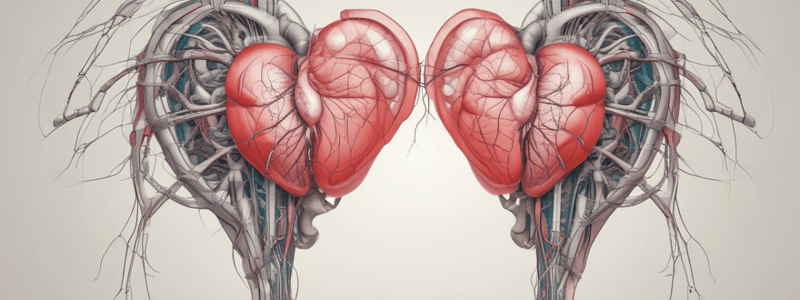Podcast
Questions and Answers
What is the primary function of the cardiac conduction system (CCS)?
What is the primary function of the cardiac conduction system (CCS)?
- To control the heart's pumping rate
- To regulate cardiac blood flow
- To regulate blood pressure
- To initiate and propagate electrical signals throughout the heart (correct)
Where is the sinus node located in the heart?
Where is the sinus node located in the heart?
- In the inferior vena cava
- Near the junction between the superior vena cava and the right atrium (correct)
- Between the right atrium and the left ventricle
- In the proximal bundle branches
What is the function of the atrioventricular node (AV node)?
What is the function of the atrioventricular node (AV node)?
- To provide adequate time for ventricular filling (correct)
- To regulate cardiac blood flow
- To initiate electrical signals in the heart
- To regulate the heart's pumping rate
What is the structure of the atrioventricular node (AV node)?
What is the structure of the atrioventricular node (AV node)?
What is the pathway of electrical conduction in the heart?
What is the pathway of electrical conduction in the heart?
What is the function of the Purkinje fibers in the heart?
What is the function of the Purkinje fibers in the heart?
What is the primary function of the Purkinje fibers in the ventricular conduction system?
What is the primary function of the Purkinje fibers in the ventricular conduction system?
Which part of the conduction system is responsible for coordinating the contractions of the atria and ventricles?
Which part of the conduction system is responsible for coordinating the contractions of the atria and ventricles?
What is the electrical conduction pathway in the heart?
What is the electrical conduction pathway in the heart?
What is the significance of the bundle of His in the ventricular conduction system?
What is the significance of the bundle of His in the ventricular conduction system?
What is the primary function of the SA node in the cardiac conduction system?
What is the primary function of the SA node in the cardiac conduction system?
During what stage of cardiac development does the linear heart tube conduct impulses slowly?
During what stage of cardiac development does the linear heart tube conduct impulses slowly?
Flashcards are hidden until you start studying
Study Notes
The Conductive System of the Heart: An Intricate Network of Nodes, Bundles, and Fibers
The heart is an intricate organ that relies on a complex system to ensure proper function. The conductive system of the heart, also known as the cardiac conduction system (CCS), is responsible for initiating and propagating electrical signals throughout the heart, coordinating the contractions of the cardiac chambers. This system is crucial for the heart's automatic rhythmic beat, ensuring that the systemic and pulmonary circulations operate in synchrony.
The Sinus Node (SA Node)
The SA node, located near the junction between the superior vena cava (SVC) and the right atrium (RA), is the dominant pacemaker of the heart. It generates electrical signals that trigger the heart's contractions. The SA node is about 10-20 mm long, 2-3 mm wide, and tends to narrow caudally toward the inferior vena cava (IVC). It is densely innervated with postganglionic adrenergic and cholinergic nerve terminals, which modulate its discharge rate through beta-adrenergic and muscarinic receptors.
The Atrioventricular Node (AV Node)
The AV node is the last point of communication between the atria and ventricles, providing adequate time for ventricular filling. It is located between the right atrium and the left ventricle, and its structure is heterogeneous, with proximal cells resembling those of the compact AV node and distal cells similar to cells in the proximal bundle branches.
The Bundle of His and the Purkinje Fibers
The bundle of His and the Purkinje fibers are part of the ventricular conduction system (VCS), also known as the His-Purkinje system (HPS). The bundle of His traverses the central fibrous body, crossing the annulus fibrosus that electrically isolates the atria from the ventricles, and then rapidly disseminates throughout the ventricular myocardium. The Purkinje fibers, which are specialized conducting cells, are found in the terminal portions of the bundle of His and are responsible for rapid ventricular conduction.
Electrical Conduction Pathway
The electrical conduction pathway in the heart involves a series of specialized cells and fibers that propagate electrical signals from the SA node to the ventricles. The pathway includes the SA node, the AV node, the bundle of His, the Purkinje fibers, and the atrial and ventricular myocardium. These components work together to ensure that the heart contracts in a coordinated and efficient manner, maximizing cardiac output while minimizing the risk of arrhythmias.
Development and Formation of the CCS
The CCS develops simultaneously with cardiac development. In the early stages of heart formation, the linear heart tube conducts impulses slowly, and ECG recordings show a sinusoidal waveform. As the heart begins to loop and form chambers, the atrial and ventricular electrocardiogram signals acquire high-frequency waveforms, indicative of rapid conduction.
In summary, the conductive system of the heart is a complex network of nodes, bundles, and fibers that are crucial for the proper function of the heart. The SA node initiates the cardiac cycle, the AV node coordinates the contractions of the atria and ventricles, and the bundle of His and Purkinje fibers ensure rapid and synchronized conduction throughout the ventricles. The development and formation of the CCS are tightly orchestrated by gene regulatory networks that produce distinct nodal and fast conduction phenotypes, ensuring the efficient and coordinated contraction of the heart.
Studying That Suits You
Use AI to generate personalized quizzes and flashcards to suit your learning preferences.



